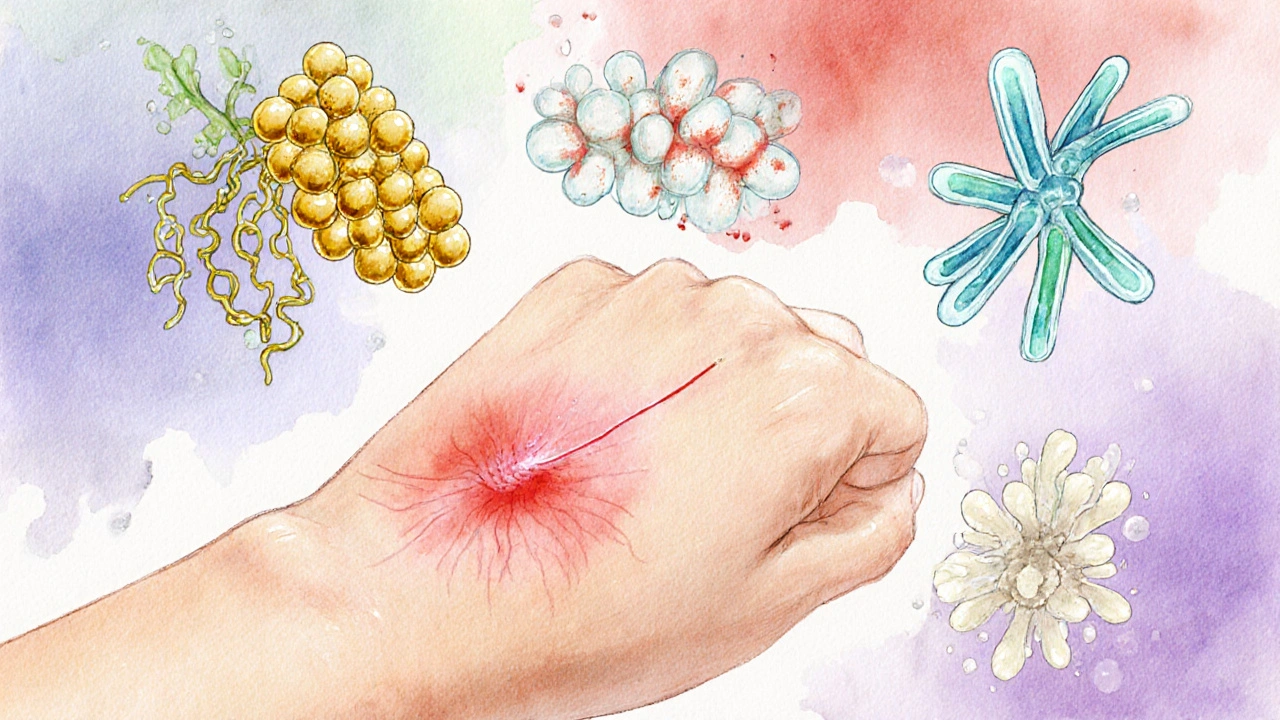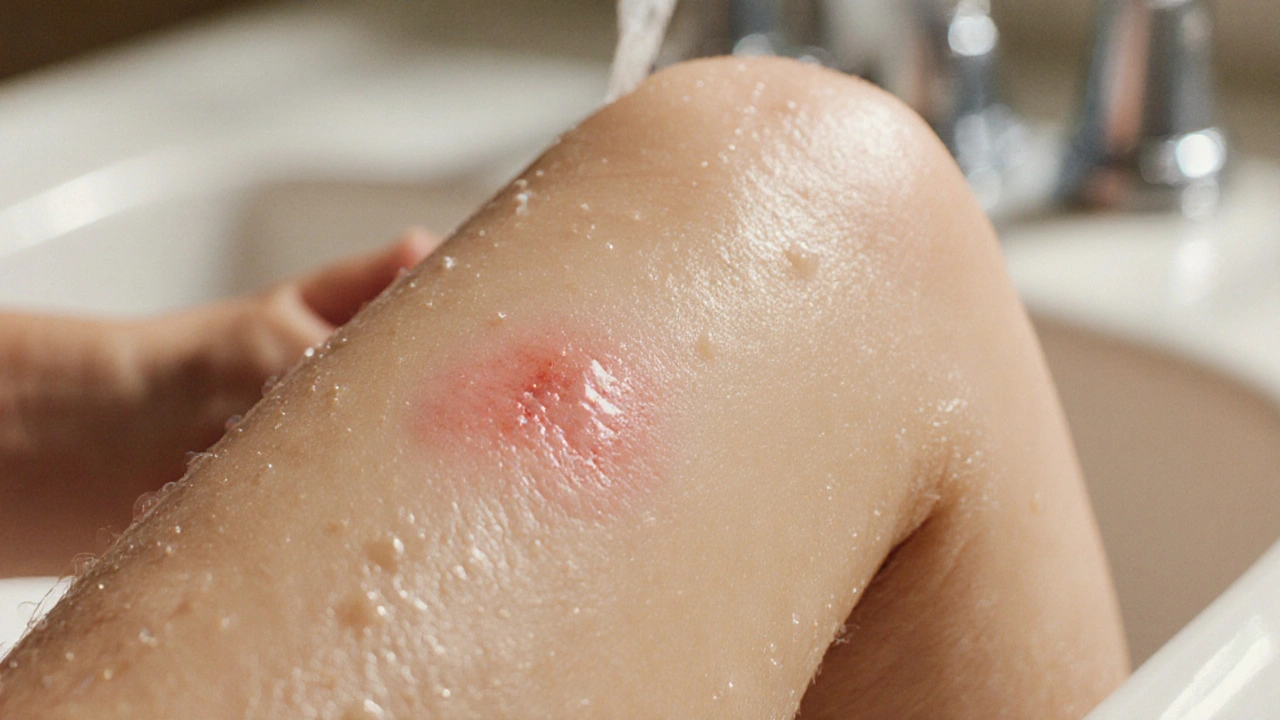Abrasions Infection Risk Calculator
Evaluate Your Abrasion Risk Factors
Please answer the following questions to assess your risk of developing an infection from this abrasion.
Infection Risk Assessment
Quick Take
- Abrasion is a superficial skin injury that can become infected if not cleaned properly.
- Common bacteria like Staphylococcus aureus and Gram‑positive cocci that love moist skin breaks cause most infections.
- Early signs include redness, swelling, warmth, pain, and pus.
- Clean the wound, apply a sterile dressing, and watch for worsening symptoms.
- Seek medical care if you notice spreading redness, fever, or the wound doesn’t improve after 48‑72 hours.
What Is an Abrasion?
When you scrape your knee on a rough surface, you get an abrasion a shallow, open wound that removes the top layers of skin (epidermis) but usually spares deeper tissue. Because the protective barrier is broken, the underlying tissue is exposed to the environment, making it a prime target for microbes.
Abrasion depth is measured in millimetres; most everyday scrapes are less than 2mm deep. The body’s natural response is to send blood to the site, forming a clot that seals the gap. If the clot stays clean, healing can finish in 3‑5 days for a small scrape.
How Infections Take Hold
Infection begins when bacteria single‑celled microorganisms that thrive on organic material or fungi colonise the wound. Several factors raise the odds:
- Moisture: Damp environments help microbes multiply.
- Foreign debris: Dirt, sand, or splinters carry pathogens.
- Compromised immunity: Diabetes, smoking, or steroids weaken the body’s defence.
- Delayed cleaning: The longer a wound sits dirty, the more time bacteria have to settle.
Once a bacterial colony establishes, it releases toxins that damage cells, prompting inflammation-manifested as redness, heat, swelling, and pain.
Common Pathogens and Their Warning Signs
Most skin‑related infections stem from a handful of bacteria. Below is a quick reference that matches the organism with typical clinical clues.
| Microbe | Key Traits | Common Signs |
|---|---|---|
| Staphylococcus aureus Gram‑positive cocci, often antibiotic‑resistant (MRSA) | Forms golden colonies; loves oily skin | Pus‑filled bumps, bright red surrounding skin, possible fever |
| Streptococcus pyogenes Group A streptococcus, causes ‘strep skin’ infections | Beta‑hemolytic on blood agar; spreads quickly | Sharp, spreading redness with a raised edge, tender to touch |
| Pseudomonas aeruginosa Gram‑negative rod, loves moist environments | Produces blue‑green pigment; resistant to many disinfectants | Greenish discharge, foul odor, especially in foot abrasions |
| Fungal species (Candida) Yeast that thrives in warm, damp skin folds | Forms white, creamy patches; may spread under nails | Itchy, red rash with satellite lesions around the abrasion |

Step‑by‑Step: How to Prevent an Infection
- Wash your hands. Use soap and water for at least 20 seconds before touching the wound.
- Rinse the abrasion. Flush with clean, lukewarm water to remove debris. A mild saline solution (0.9% NaCl) works well.
- Disinfect gently. Apply an over‑the‑counter antiseptic such as hydrogen peroxide a 3% solution that kills surface bacteria or povidone‑iodine. Avoid scrubbing hard; you don’t want to damage new tissue.
- Cover the wound. Use a sterile wound dressing non‑adhesive gauze or hydrocolloid pad that keeps moisture balanced. Change the dressing daily or when it becomes wet.
- Monitor for changes. Keep a log of colour, size, and any discharge. Photographing the abrasion can help you track progress.
Following these steps reduces the bacterial load dramatically, giving your body a clean slate to heal.
When to Seek Professional Help
Most small scrapes heal fine at home, but certain red flags demand a clinician’s eye:
- Redness spreading more than 2cm from the wound edge.
- Increasing pain despite dressing changes.
- Fever above 38°C (100.4°F) or chills.
- Pus that is thick, yellow‑green, or foul‑smelling.
- Underlying conditions (diabetes, peripheral vascular disease) that impair healing.
In those cases, a doctor may take a swab for culture, prescribe oral antibiotics, or recommend a tetanus booster if you haven’t had one in the last ten years.
Treatment Options for an Infected Abrasion
Once infection is confirmed, treatment follows a tiered approach:
- Topical antibiotics. Creams like bacitracin or mupirocin target most Gram‑positive skin bugs.
- Oral antibiotics. For deeper or spreading infections, doctors often start with dicloxacillin effective against Staphylococcus and Streptococcus species. If MRSA is suspected, trimethoprim‑sulfamethoxazole may be chosen.
- Debridement. In severe cases, a health professional removes dead tissue to allow fresh blood flow.
- Follow‑up care. Re‑evaluate the wound after 48‑72hours to ensure the infection is receding.
Never share antibiotic ointments across people; resistance is a real threat.
Aftercare: Getting Back to Normal
Even after the infection clears, proper aftercare speeds up full recovery:
- Keep the area moisturised with a thin layer of petroleum jelly once the scab falls off.
- Protect the spot from friction-use padding if you return to sports.
- Maintain a balanced diet rich in vitaminC, zinc, and protein to support tissue repair.
- Stay hydrated; fluids help transport nutrients to the healing skin.
Within two weeks, most uncomplicated abrasions fade without noticeable scarring. If a scar does form, silicone gel sheets can soften its appearance over several months.
Frequently Asked Questions
Can I use tea tree oil on a scraped knee?
Tea tree oil has mild antiseptic properties, but it can irritate fresh skin. Dilute it to less than 1% and only apply after the wound has formed a thin scab. If you notice burning, wash it off.
Do I need a tetanus shot for a scrape?
If the abrasion was caused by a dirty object and your last tetanus booster was over ten years ago, get a booster. For clean, minor scrapes, it’s usually not necessary.
Why does my abrasion turn pink instead of red when it heals?
Pink indicates new capillary growth-your body is laying down fresh tissue. It’s a normal part of the healing cascade and a good sign that infection is not present.
Is it safe to expose a healing abrasion to sunlight?
Moderate sunlight can boost vitaminD, which aids healing, but direct UV can darken scars. Cover the area with a breathable bandage if you’ll be out for long periods.
How long does it usually take for an infected abrasion to clear?
With appropriate antibiotics and wound care, most infections improve within 3‑5 days and fully resolve in 1‑2 weeks. Delays beyond that suggest deeper issues and merit a re‑evaluation.

Camille Ramsey
A scraped knee is not just a trivial annoyance, it's a microcosm of our mortality.
If you ignore the proper protocol, you are essentially courting infection with reckless abandon.
The skin barrier, when breached, becomes a battlefield where microbes wage silent war.
Your negligence in cleaning is akin to inviting strangers into your living room without asking.
Do not be fooled by the superficial calm; beneath the scab lies a potential epidmy, definatly not something to ignore.
Proper antiseptic application is not optional, it's a duty owed to your own flesh.
The phrase 'just let it heal' is a dangerous mantra that betrays basic biology.
Wash your hands, rinse the wound, and cover it-three steps that any competent adult can perform.
If you fail to do so, you are complicit in the creation of a pus-filled disaster.
Consider the cost of a doctor visit versus the few seconds spent on proper care.
Your immune system is not a magic shield; it needs assistance when you provide a feast for bacteria.
Moisture and debris are the perfect fertilizer for the bacterial garden.
Put a sterile dressing on; let it breathe, but don't let it drown.
Monitor the edges for spreading redness, because that is the first whisper of infection.
In short, treat an abrasion with the seriousness of a minor war, and you will emerge victorious.
Scott Swanson
Oh great, another guide about scrapes-because we were all clueless about washing our hands, right? Let’s all pretend we’ve never seen a bandage before. Seriously though, kudos for the thoroughness; anyone who skipped the step of rinsing a wound probably thinks germs are a myth. Keep spreading the knowledge, folks.
Karen Gizelle
Honestly, if you treat a simple abrasion like a casual afterthought, you’re endorsing a culture of negligence. We should demand higher standards of self‑care, not accept laziness as normal. The moment you skip the antiseptic is the moment you betray your own body. Stop making excuses-teh only thing standing between you and infection is your own effort.
Stephanie Watkins
I’m curious about the recommended duration for changing dressings-does the article suggest a specific timeframe, or is it left to personal judgment? Also, what type of saline solution is considered optimal for rinsing without irritating new tissue?
Zachary Endres
Great questions! Change the dressing at least once a day, or sooner if it gets wet. A simple 0.9% saline works wonders-think of it as giving your wound a gentle rinse of hope!
Ashley Stauber
All this 'global best practice' talk ignores the fact that American outdoorsmen have survived scrapes for centuries without fancy calculators. Our ancestors relied on raw common sense, not on some foreign algorithm.
darren coen
Cleaning a wound properly is common sense.
Jennifer Boyd
Your philosophical war analogy totally rocks! I’ll arm my bandages and battle those germs like a hero in a medieval epic.
Lauren DiSabato
While your dramatization is amusing, let’s not romanticize infection management-clinical protocols are grounded in evidence, not chivalric fantasies. One must appreciate the nuanced pharmacodynamics rather than glorify the battlefield.
Hutchins Harbin
I appreciate the thorough guide; the step‑by‑step list really helps me feel confident in treating minor cuts.